文章信息
- 潘延鑫, 罗纨, 贾忠华, 刘文龙, 李山, 武迪
- PAN Yanxin, LUO Wan, JIA Zhonghua, LIU Wenlong, LI Shan, WU Di
- 排水沟蓄水条件下农田与排水沟水盐监测
- Monitoring salt and water dynamics in farmland and drainage ditch in a saline environment under reduced drainage intensity
- 生态学报, 2014, 34(3): 597-604
- Acta Ecologica Sinica, 2014, 34(3): 597-604
- http://dx.doi.org/10.5846/stxb201307261948
-
文章历史
- 收稿日期:2013-7-26
- 修订日期:2014-1-20
排水系统作为农田水利基础设施的最主要功能就是及时将田间过多的水分排出农田,起到排涝降渍[1]、维持灌区水盐平衡[2, 3, 4]和控制土壤盐渍化[5, 6, 7]的作用。近年来,大量研究成果[8, 9, 10]显示许多灌区现有的排水系统存在着排水过度问题,这不仅造成下游受纳水体的污染[11, 12, 13]而且还浪费了宝贵的水资源[14, 15, 16]。如何通过工程和管理措施来调控农田水盐均衡,从而实现农业生产的可持续发展是当前我国经济发展和环境保护中亟待解决的科学问题。
在一些半干旱、半湿润灌区内,排水沟由于排水出路受阻,并受到灌溉水或降水、以及来自上游或周边水源的补给,使得排水沟周期性的保持较高水位运行,形成了排水沟蓄水条件,此时区域水盐平衡受到影响[17, 18],农田土壤是否会发生积盐而影响作物正常生长成为关注的焦点。例如,美国加州San Joaquin Valley 灌区因排水中富含有硒元素致使排水出路被封堵后,科研人员开展了大量关于作物在较高地下水位情况下生长的水盐平衡研究[19, 20, 21]。部分研究结果已表明,灌区排水系统运行模式改变后,适当的农田水位管理措施可以满足农业生产可持续发展的要求。
位于陕西省富平县境内的卤泊滩灌区在历史上曾为古湖泊洼地,盐分累计较多,近代被开垦为农田,但盐渍化问题一直很严重。1999年,当地有关部门通过土地平整和健全灌排系统措施,实施了卤泊滩盐碱地深度治理。在治理过程中,受到经济因素和环境保护要求限制,通往滩外的排水干沟未能完成,灌溉季节的排水只能滞留在排水沟和下游一片洼地内。由于地势较低,卤泊滩排水沟系统除了负担本区内的灌溉排水以外,还受到两个上游引黄灌区在灌溉季节退水的影响,沟内水位周期性的升高,形成了排水沟蓄水条件。近10年来,区内未发生大面积的盐渍化,种植的玉米、棉花等农作物生长基本正常。为了查明排水沟蓄水条件下农田与排水沟之间水盐运动的基本情况,在陕西省卤泊滩盐碱地改良区开展了两年水盐监测的试验工作,根据这些实地监测数据,研究了灌区农田与排水沟之间的水盐动态变化关系,以便探讨农田水文过程变化对盐分运移以及农业生产的影响,成果可为类似区域盐碱地治理与生态环境保护提供理论依据。
1 材料与方法 1.1 研究区气象条件根据陕西富平县气象部门提供的数据,卤泊滩盐碱地改良区多年平均降雨量为498mm,降雨多集中在7—9月,占全年降雨量的49%,其他季节较干旱。全年蒸发量1000—1300mm,是降雨量的2—2.3倍。年平均气温13.4℃,夏季最高气温41.8℃。研究区多年平均月降雨以及气温和蒸发量如图1所示。
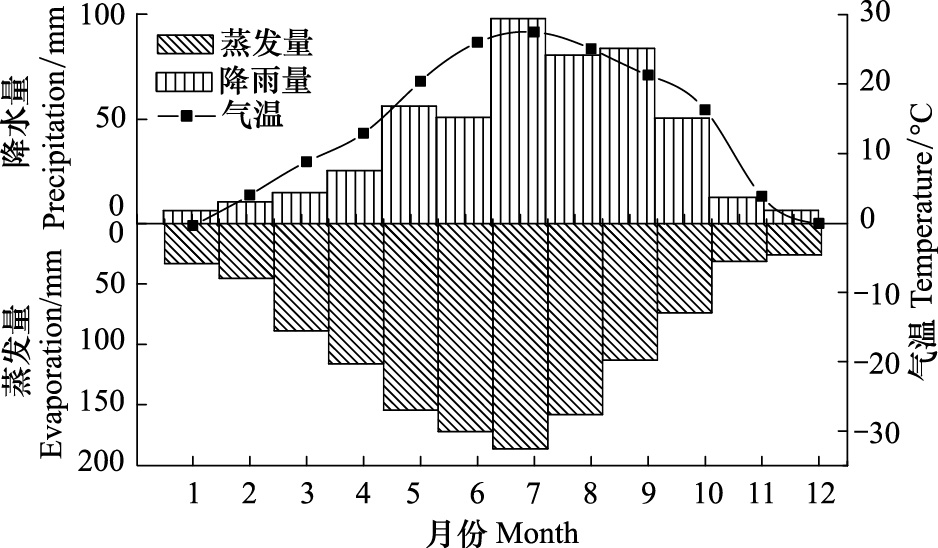
|
| 图1 研究区气象资料 Fig. 1 The long term average monthly weather data in the study area |
如图2所示,在卤泊滩盐碱地改造一期项目区的上游地段选取了两块400m×100m农田进行观测。2009年6月到2010年10月的观测时段内,田块A种植棉花,田块B种植玉米。在每个田块中间布置了观测断面,每个断面上各布置3组观测井,每组分别有深度为1m,2m,3m的3个井(图2),用来观测地下水位和不同埋深处的水质。同时两个观测断面农田一侧的排水农沟里安装了水尺,并确定了水质取样点,以便同时观测排水沟水位与田间地下水位以及水质的变化。此外,在研究区内3条排水干沟(图2中P、N、M沟)上从上游到下游依次布设了监测点,与农田断面A、B同时进行水质与水位监测。图2中箭头代表水流方向,上游灌区退水自西边进入卤泊滩,流入M沟,水量较大时,部分水量沿相反方向进入N沟与P沟。本文研究内容仅限于对农田与两侧排水沟水盐动态关系的分析。
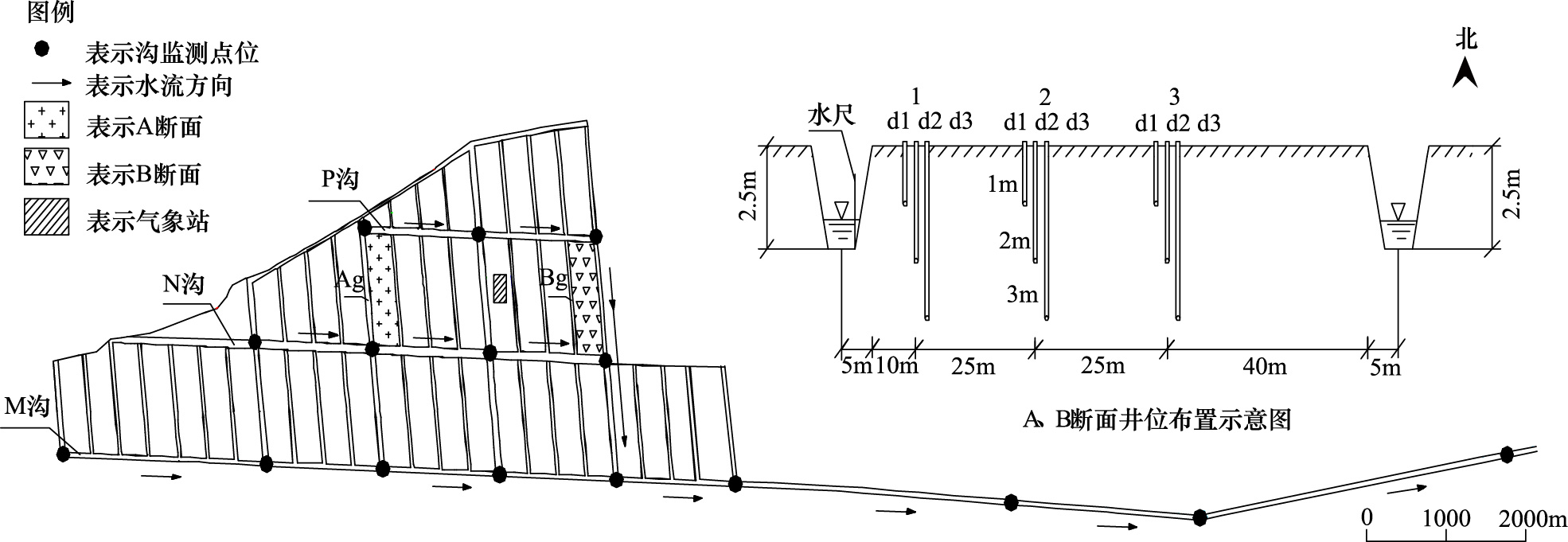
|
| 图2 研究区监测断面及监测点布设图 Fig. 2 Layout of the monitoring fields and sampling locations in the study area |
为了监测研究区的水文气象情况,在现场安装了一个小型气象站,实时记录当地降雨量、温度等气象数据。水位测量与水质取样每2—3周进行1次,同时下载气象数据。对于地下水观测,每次取样过程中,首先用自制水位测量仪记录观测井中的水位,然后用汲水桶将井中的积水排空,待井中水面再现后,提取水样带回实验室。排水沟水位、水质测量与地下水观测过程同步进行。根据研究目标,水质测量指标仅限于盐分含量。所采集水样在实验室用美国哈西Sension156测量仪测定电导率。
2 结果与分析 2.1 监测期内研究区月降雨及潜在腾发量图3显示2009年6月25日到2010年10月18日期间,在研究区内实测的月降雨量以及根据气温、湿度、风速等气象资料按FAO-56推荐的Penman-Monteith公式计算潜在腾发量。与图1显示的多年平均结果相比,监测期内降水与蒸散状况可以代表研究区的正常气候状况,对观测农田水分蒸散和地下水位的影响比较典型。

|
| 图3 试验期2009年6月25日—2010年10月18日蒸发与降雨量 Fig. 3 Monthly PET and precipitation during the monitoring period |
观测期内,A、B田块观测井组1m井中一直没有水,2m井中有少量水,3m井中水较多。说明在此期间农田地下水埋深保持在2m左右。3组观测井中同一深度井中的水位基本一致,表明田间地下水面平坦,上下波动一致。因此A、B田块中地下水埋深分别取3m井观测结果的平均值,与降雨量一起绘于图4、图5中。
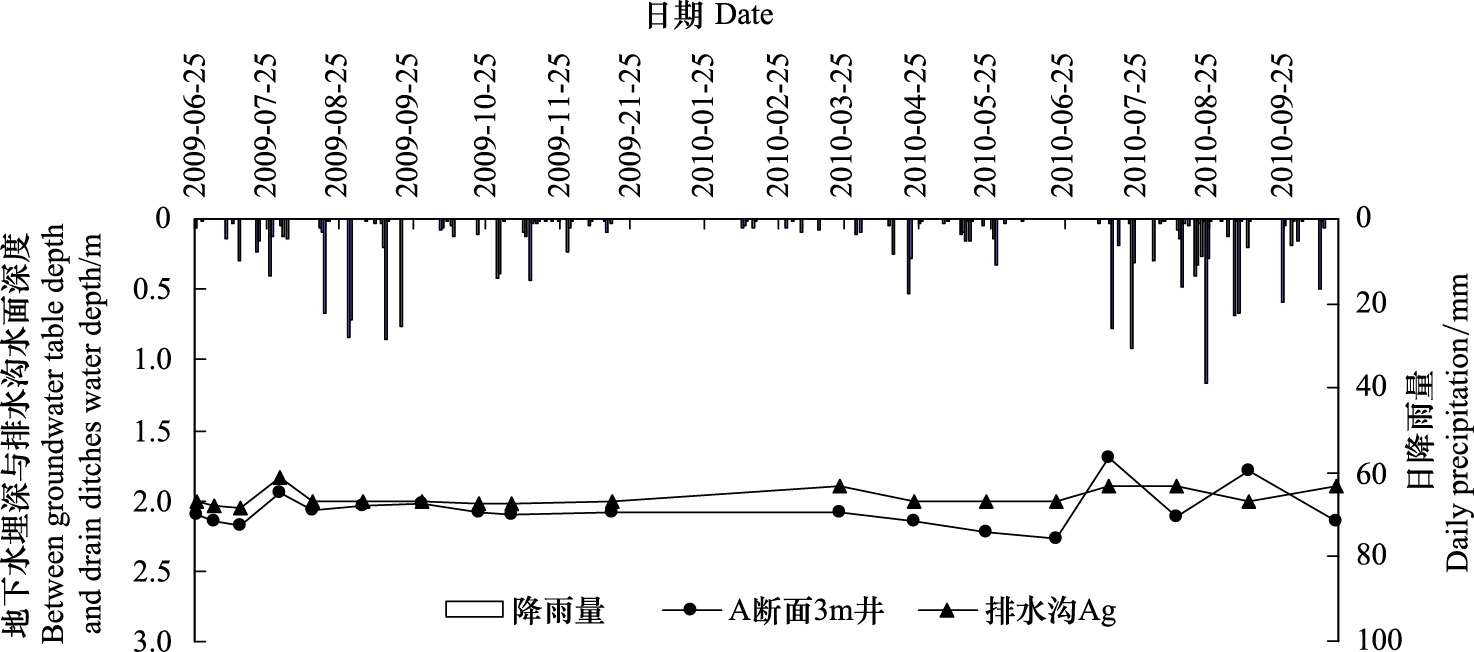
|
| 图4 A断面排水沟水位及农田地下水埋深变化图 Fig. 4 Depth to water table in field A and its drainage ditch Ag |
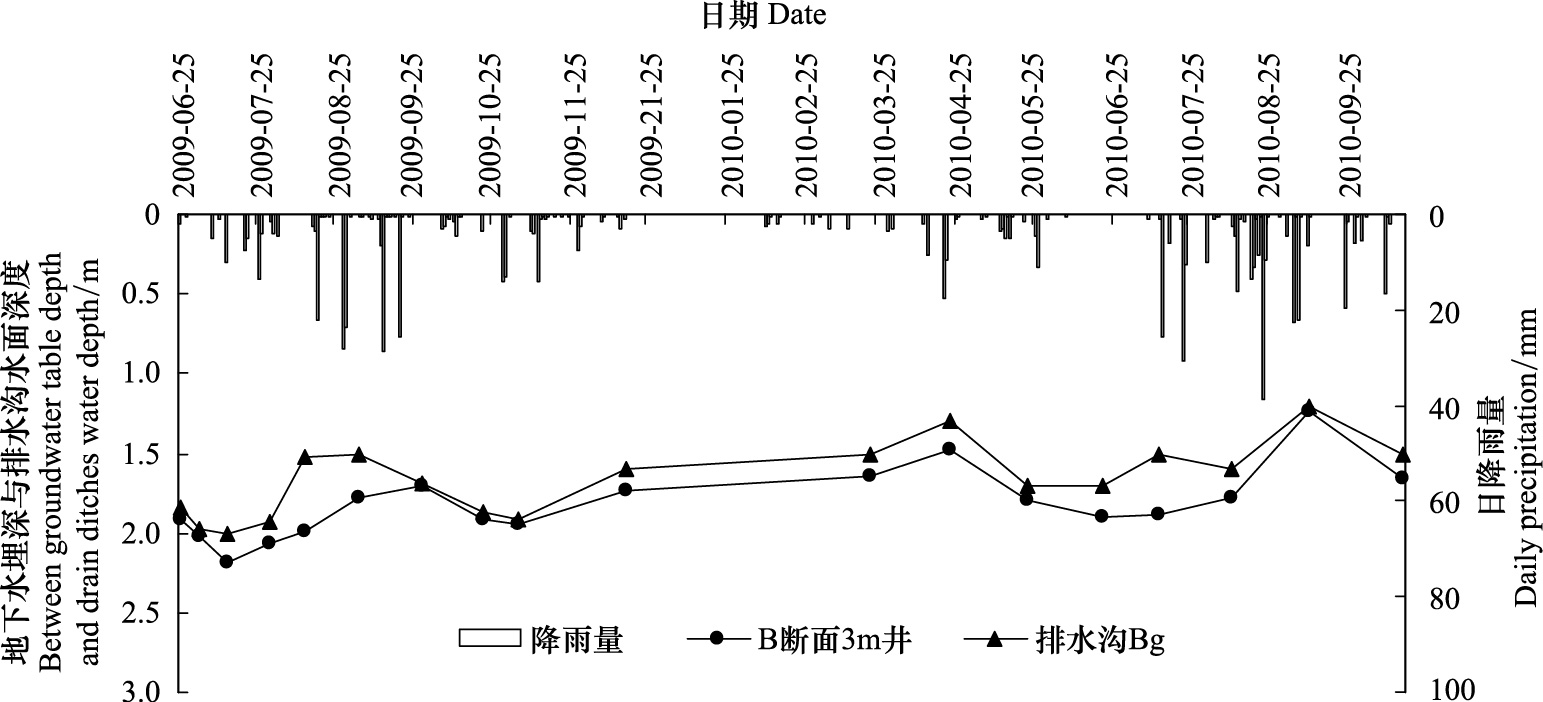
|
| 图5 B断面排水沟水位及农田地下水埋深变化图 Fig. 5 Depth to water table in field A and its drainage ditch Bg |
图4显示2009年6月至2010年10月间A断面农田地下水埋深以及相邻排水沟(Ag)内水面深度变化情况。由图可见,农田地下水与排水沟水位波动基本一致。虽然两个生长季内都有多次降雨过程,但因气温较高、蒸发蒸腾作用强烈、且非饱和土层深度接近2m,降雨未能形成对地下水的有效补给。2009年观测到的A断面最大埋深为2.2m,此时排水沟内水位高于田间约20cm;2010年观测到的A断面最大埋深为2.3m,而此时排水沟内水位高于田间约30cm。观测期有大量来自上游灌区的退水进入研究区内的排水沟系统,但因A断面田块所处的位置与其他干沟的水力连通性较差,排水沟及农田地下水位未受到明显影响。
图5显示B断面地下水埋深及相邻排水沟(Bg)内水面变化情况。受到区域地下水以及相邻排水干沟的影响,B断面地下水埋深较A断面浅,且波动较大。与A断面水位变化类似,2009年6月初到7月中旬期间,因无明显降雨过程,排水沟与农田地下水位均处于下降趋势,降至最低点2.2m,之后受降雨及灌溉水量补给,水位抬升。与A断面不同的是,B断面农田一侧的排水沟受来自上游灌区的退水影响较大。如2009年8月中旬,有部分水量进入B断面农田一侧的排水沟(Bg),使得沟水位上升,农田地下水位上升滞后于排水沟。与A断面不同的是,排水沟水位始终高于农田地下水位约15cm。
表 1显示出农田A、B断面地下水埋深的变异系数较小,表明其地下水位相对稳定。其中排水沟Bg水位变异系数明显大于沟Ag。由图5可见,排水沟Bg所处的位置使其更易受到自干沟流入的上游灌区退水影响,致使其水位变化较大;而排水沟Ag内水位的变异系数较小,表明其受到退水的影响很小。
| 监测位置 and Monitoring location | 最大值/m and Maximum value | 最小值/m and Minimum value | 均值/m and Average value | 标准偏差/m and Standard deviation | 变异系数 and Variable coefficient |
| 农田A断面 Monitoring A field | 2.27 | 1.69 | 2.06 | 0.14 | 0.07 |
| 农田B断面 Monitoring B field | 2.18 | 1.24 | 1.79 | 0.22 | 0.12 |
| 排水沟Ag Drainage ditch (Ag) | 2.05 | 1.84 | 1.98 | 0.06 | 0.03 |
| 排水沟Bg Drainage ditch (Bg) | 2.00 | 1.16 | 1.65 | 0.23 | 0.14 |
排水沟与农田地下水位监测及统计分析结果显示二者之间存在一定的水力联系。尤其是B断面,排水沟与农田地下水位的变化表现出了良好的一致性。由于地势和沟深等缘故使得两断面地下水位变化趋势和幅度略有不同,但总的来看,监测断面地下水埋深都维持在2m左右。
根据盐碱化地区潜水蒸发规律,埋深愈浅,蒸发愈大,积盐也就愈快。观测结果表明,研究区农田地下水埋深始终保持在2m左右,观测期间,农田蒸散作用将田间地下水埋深最低降至2.2m。农田中积盐现象不甚明显,表明在研究区的水文气象条件下,高矿化度地下水中的盐分没有随毛管水上升到耕作层中。
2.3 农田地下水与排水沟电导率监测结果分析在观测水位的同时,对农田A、B断面2m、3m井以及排水沟的电导率进行了取样分析,测定其电导率(图6,图7)。因为2m井中经常取不到水样,且有限的数据显示2m与3m井水电导率差异不大,所以图中显示的是3m井和排水沟水样的电导率监测结果。由图可见,两块农田的地下水含盐量电导率值在4—12ms/cm之间,均为不宜灌溉的劣质水。A断面(图4)农田排水沟Ag内水样电导率与农田地下水电导率几乎没有差别,说明二者具有密切的水力联系。
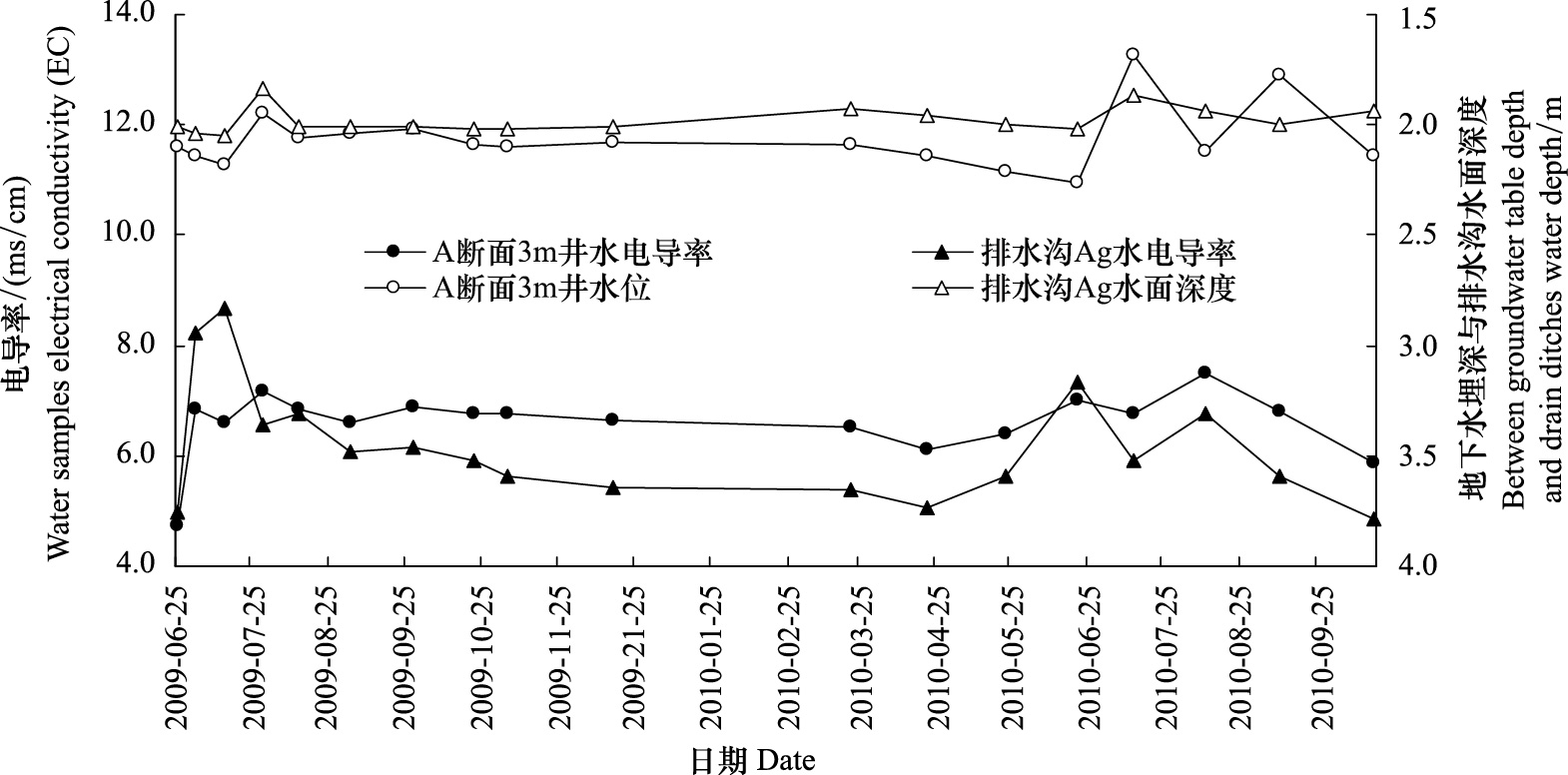
|
| 图6 A断面3m监测井及排水沟Bg水样电导率变化图 Fig. 6 Measured EC of groundwater from 3m monitoring wells in field A and drainage ditch Ag |
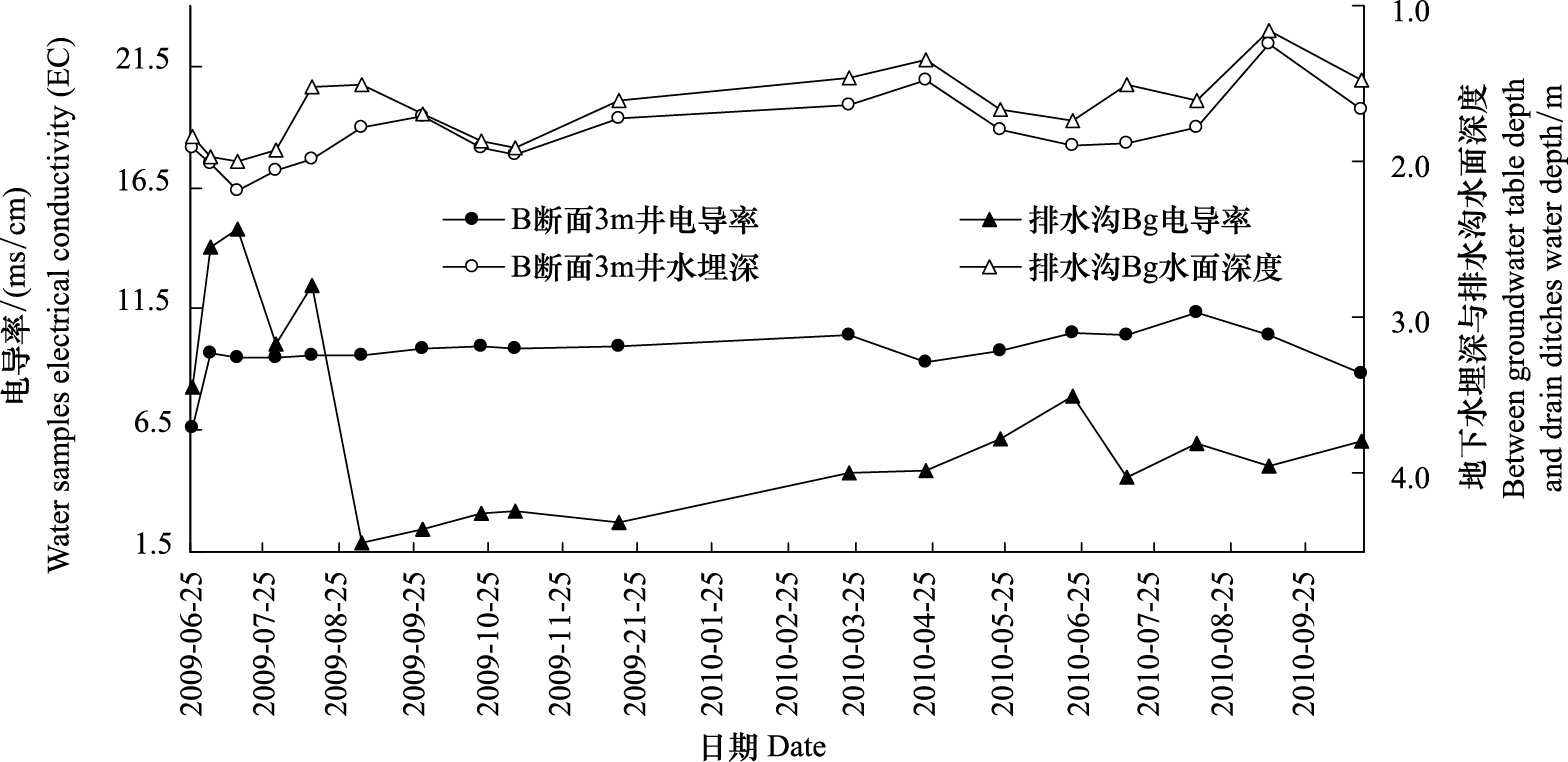
|
| 图7 B断面3m监测井及排水沟Bg水样电导率变化图 Fig. 7 Measured EC of groundwater from 3m monitoring wells in field B and drainage ditch Bg |
图7显示B断面农田排水沟Bg内的盐分浓度受降雨、退水的影响变化明显,2009年8月中旬退水期间,排水沟中水盐分浓度急剧下降,电导率由12.5ms/cm下降到1.9ms/cm,下降了84.8%。此后随着沟水位逐渐回落,Bg沟中水的电导率值略有增高,但仍明显低于农田地下水。虽然水位监测结果显示B断面农田地下水位在退水期有一定升高,但监测结果显示盐分却未受到地下水水位上升的显著影响。自9月以后观测到了2m深井内的水样电导率状况,其中A断面2m井水的电导率略高于3m井,B断面2m井水的电导率则略低于3m井,但二者都没有显著的差别,说明2m到3m之间地下水含盐量无明显变化。2010年A断面3m井与排水沟水样的电导率具有同步变化的趋势,且3m井的水样电导率值高于排水沟,除6月下旬的一次农田灌溉使得农田土壤盐分被淋洗导致排水沟盐分浓度略高于农田3m井。而B断面受春灌退水的影响,4月下旬地下水位上升,而水样电导率值降低,之后到7月底由于作物耗水和干旱,地下水位逐渐上升,电导率相应升高。8—10月份由于降雨充沛,地下水位明显抬升,其电导率值显著降低。图中还显示排水沟水样电导率值始终低于农田。
表 2显示,农田监测断面地下水电导率均值高于排水沟水样的电导率均值,在0.05的显著性水平上,A断面的差别不显著,B断面的差别显著。农田A、B断面地下水电导率的变异系数较小,表明其含盐量变化不大。B断面排水沟水样电导率的变异系数最大,为0.59,说明观测期间该沟内水体的含盐量发生了较大的变化,这主要是因为B断面排水沟受到外来淡水的补给,使沟内盐分浓度得到稀释的原因;而A断面排水沟受到外来水补给的量很小,沟内水样电导率的变化不大,且与农田地下水电导率变化基本保持一致。
| 监测位置 and Monitoring location | 水样电导率单位/(ms/cm) | |||||||
| 最大值 | 最小值 | 均值 | 标准偏差 | 变异系数 | t-统计值 | p值 and (ɑ=0.05) | 显著性 and Statistical and significance | |
| A断面3m井 3m well in A field | 7.51 | 4.72 | 6.55 | 0.60 | 0.09 | 1.83 | 0.092 | 不显著 |
| 排水沟Ag Drainage ditch (Ag) | 8.69 | 4.86 | 6.32 | 1.15 | 0.18 | |||
| B断面3m井 3m well in B field | 11.40 | 6.58 | 9.66 | 0.97 | 0.10 | 3.32 | 0.003 | 显著 |
| 排水沟Bg Drainage ditch (Bg) | 14.75 | 1.90 | 7.05 | 4.14 | 0.59 | |||
本文的研究对象陕西省富平县卤泊滩盐碱地改良区位于一个低洼地带,地下水运动滞缓,受区域排水以及气候条件的影响,农田潜在盐渍化威胁。排水沟蓄水条件不仅改善了农田小气候,而且调节了农田土壤水分分布,达到抑制土壤盐分、提高作物对水分利用效率的目的。通过对研究区连续两年的水盐监测资料进行分析,得到以下结果:
(1)在排水沟蓄水条件下卤泊滩盐碱地改良区农田地下水位基本稳定在2m左右,相邻排水沟水位与农田地下水位变化基本一致,在有上游灌区退水进入排水沟的情况下,农田一侧排水沟水位明显高于田间地下水位。
(2)对两块农田地下水与排水沟电导率监测结果表明,在无外界来水干扰的情况下,农田地下水和排水沟水样的电导率变化趋势一致,排水沟蓄水条件能够有效地控制农田水盐运动;当排水沟受到外来淡水补给时,沟内浓缩的盐分得到稀释,电导率明显低于农田地下水。
| [1] | Wang S L, Qu X Y. Dynamic control of drainage and calculation method of drainage spacing based on the idea of combining the control of salinization with subsurface waterlogging. Journal of Hydraulic Engineering, 2008, 39(11): 1204-1211. |
| [2] | Zhang W Z, Zhang Y F. Knowledge of water-and-salt balance and control of soil saline-and-water-logging in Irrigation District. China Rural Water and Hydropower, 2003, (8): 13-18. |
| [3] | Chen X B, Yang J S, Yang Z H, Hu S J, Liu G M. Irrigation-drainage management and hydro-salinity balance in Weigan River Irrigation District. Transactions of the Chinese Society of Agricultural Engineering, 2008, 24(4): 59-65. |
| [4] | Pan Y X, Luo W, Jia Z H, Li J, Chen Y. Experiment on salt exchange between sediments and ponding water in drainage ditches of saline farmland. Transactions of the Chinese Society of Agricultural Engineering, 2013, 29(2): 81-87. |
| [5] | Jiao Y P, Kang Y H, Wan S Q, Sun Z Q, Liu W, Dong F. Effect of soil matric potential on the distribution of soil salt under drip irrigation on saline and alkaline land in arid regions. Transactions of the Chinese Society of Agricultural Engineering, 2008, 24(6): 53-58. |
| [6] | Pan Y X, Luo W, Jia Z H, Li J, Chen Y. Salinity variation in water and the sediments of drainage ditches in a saline agricultural environment. Journal of Soil and Water Conservation, 2012, 26(5): 182-185. |
| [7] | Sun X J, Wang Z C, Zhao C W, Xu L, Dong Y. Impact assessment of saline-sodic agricultural drainage on water quality invented area of Chagan Lake. Transactions of the Chinese Society of Agricultural Engineering, 2011, 27(9): 214-219. |
| [8] | Luo W, Jia Z H, Skaggs R W, Xi W Y, Zhang Y F. Rice fields drainage process simulation in Yinnan irrigation district with DRAINMOD model. Transactions of the Chinese Society of Agricultural Engineering, 2006, 22(9): 53-57. |
| [9] | Sun J S, Kang S Z. Present situation of water resources usage and developing countermeasures of water-saving irrigation in China. Transactions of the Chinese Society of Agricultural Engineering, 2000, 16(2): 1-5. |
| [10] | Guitjens J C, Ayars J E, Grismer M E, Willardson L S. Drainage design for water quality managements overview. Journal of Irrigation and Drainage Engineering, 1997, 123(3): 148-153. |
| [11] | Skaggs R W,Chescheir G M .Effects of subsurface drain depth on nitrogen losses from drained lands.American Society of Agricultural Engineers,2003,46(2):237-244. |
| [12] | Luo W, Jia Z, Fang S, Wang N, Liu J, Wang L, Tian S, Zhang Y. Outflow reduction and salt and nitrogen dynamics at controlled drainage in the Yinnan Irrigation District, China. Agricultural Water Management, 2008, 95(7): 809-816. |
| [13] | Li Q K, Hu Y W, Sun J, Li H E. Loss characteristics of agricultural non-point source pollutants under controlled drainage. Transactions of the Chinese Society of Agricultural Engineering, 2010, 26(Suppl 2): 182-187. |
| [14] | Han J C, Xie J C, Zhu J W, Wang T. Comprehensive method for treatment of saline lands. Journal of Hydraulic Engineering, 2009, 40(3): 327-377. |
| [15] | Pan Y, Xie J C, Zhu J W, Han J C. Assessment system for harmonious ecosystem of saline land. Journal of Hydraulic Engineering, 2009, 40(3): 492-497. |
| [16] | Han J C, Xie J C, Wang T, Luo L T, Zhu M L, Ye X F. Experimental observation of saline alkali of soil in saline land after changing drainage to impoundment in Lubotan of Shaanxi Province. Transactions of the Chinese Society of Agricultural Engineering, 2009, 25(6): 59-65. |
| [17] | Jia Z, Luo W, Xie J, Pan Y, Chen Y, Tang S, Liu W. Salinity dynamics of wetland ditches receiving drainage from irrigated agricultural land in arid and semi-arid regions. Agricultural Water Management, 2011, 100(1): 9-17. |
| [18] | Ayars J E, Christen E W, Hornbuckle J W. Controlled drainage for improved water management in arid regions irrigated agriculture. Agricultural Water Management, 2006, 86(1/2): 128-139. |
| [19] | Ayars J E, Christen E W, Soppe R W, Meyer W S. The resource potential of in-situ shallow ground water use in irrigated agriculture: a review. Irrigation Science, 2006, 24(3): 147-160. |
| [20] | Doering E J, Benz L C, Reichman G A. Shallow-water-table concept for drainage design in semiarid and subhumid regions//American Society of Agricultural Engineers (eds). Advances in drainage, proceedings of the fourth national drainage symposium. St Joseph, Michigan: American Society of Agricultural Engineers, 1982, 34-41 |
| [21] | Evans R O, Skaggs R W, Gilliam J W. Controlled versus conventional drainage effects on water quality. Journal of Irrigation and Drainage Engineering, 1995, 121(4): 271-276. |
| [1] | 王少丽, 瞿兴业. 盐渍兼治的动态控制排水新理念与排水沟(管) 间距计算方法探讨. 水利学报, 2008, 39(11): 1204-1211. |
| [2] | 张蔚榛, 张瑜芳. 对灌区水盐平衡和控制土壤盐渍化的一些认识. 中国农村水利水电, 2003, (8): 13-18. |
| [3] | 陈小兵, 杨劲松, 杨朝晖, 胡顺军, 刘广明. 渭干河灌区灌排管理与水盐平衡研究. 农业工程学报, 2008, 24(4): 59-65. |
| [4] | 潘延鑫, 罗纨, 贾忠华, 李进, 陈远. 盐碱地排水沟蓄水后底泥与水体盐分交换试验. 农业工程学报, 2013, 29(2): 81-87. |
| [5] | 焦艳平, 康跃虎, 万书勤, 孙泽强, 刘伟, 董锋. 干旱区盐碱地滴灌土壤基质势对土壤盐分分布的影响. 农业工程学报, 2008, 24(6): 53-58. |
| [6] | 潘延鑫, 罗纨, 贾忠华, 李进, 陈远. 农田排水沟水体与底泥中盐分迁移研究. 水土保持学报, 2012, 26(5): 182-185. |
| [7] | 孙晓静, 王志春, 赵长巍, 徐璐, 董燕. 盐碱地农田排水对查干湖承泄区的水质影响评价. 农业工程学报, 2011, 27(9): 214-219. |
| [8] | 罗纨, 贾忠华, Skaggs R W, 席伟彦, 张永锋. 利用DRAINMOD模型模拟银南灌区稻田排水过程. 农业工程学报, 2006, 22(9): 53-57. |
| [9] | 孙景生, 康绍忠. 我国水资源利用现状与节水灌溉发展对策. 农业工程学报, 2000, 16(2): 1-5. |
| [13] | 李强坤, 胡亚伟, 孙娟, 李怀恩. 控制排水条件下农业非点源污染物流失特征. 农业工程学报, 2010, 26(增刊2): 182-187. |
| [14] | 韩霁昌, 解建仓, 朱记伟, 王涛. 陕西卤泊滩盐碱地综合治理模式的研究. 水利学报, 2009, 40(3): 372-377. |
| [15] | 潘宜, 解建仓, 朱记伟, 韩霁昌. 陕西省卤泊滩盐碱地和谐生态系统评价体系. 水利学报, 2009, 40(4): 492-497. |
| [16] | 韩霁昌, 解建仓, 王涛, 罗林涛, 朱满林, 叶校飞. 陕西卤泊滩盐碱地“改排为蓄”后盐碱指标试验观测. 农业工程学报, 2009, 25(6): 59-65. |
 2014, Vol. 34
2014, Vol. 34




